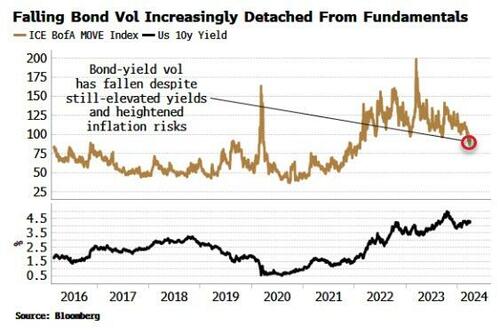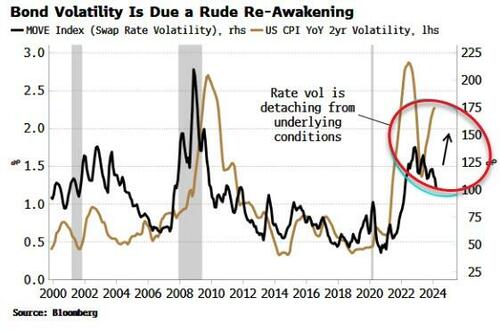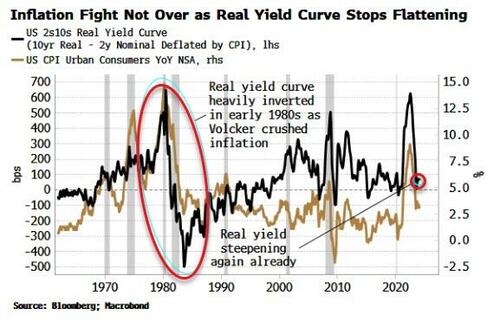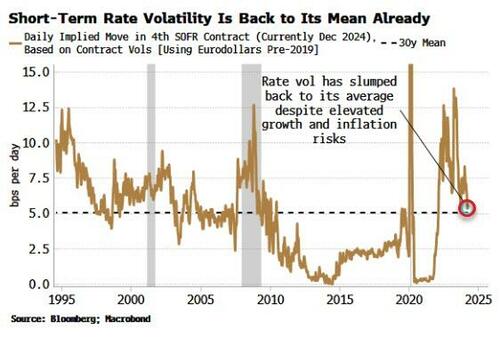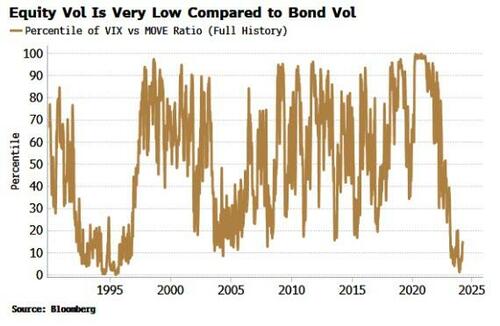Bond Market's Eerie Calm Belies Bigger Move On Way
Authored by Simon White, Bloomberg macro strategist,
Volatility in US interest rate and bond markets is poised to move much higher as it re-attaches to underlying fundamentals. That means higher rates and greater stock volatility, leaving especially high-duration sectors such as tech exposed to underperformance and potential downside.
There is something of a preternatural calm to bond markets at the moment. Despite upside growth and inflation risks bubbling up, bond volatility has been in a downward trend for the past six months. It remains much lower than the highs it reached in 2022, and the spasm that was the SVB crisis in 2023.
But there are mounting signs that this won’t last, and we should soon see larger moves in yields again with an upward bias. That also means the currently-depressed VIX is poised to move higher. After a recess, volatility is coming back.
Low or falling volatility often precedes big moves. If you need an example, consider gold and silver. Their volatility fell to multi-year lows in February, ahead of both metals surging higher in recent days.
The MOVE index is the bond equivalent of the VIX. It uses a range of options on interest-rate swaps of different maturities to gauge the average level of rate volatility. As with the VIX, it was very low in the early years of the pandemic as the Federal Reserve pulled out all the stops to avert an economic calamity.
But unlike the VIX, the MOVE rose sharply as the Fed began to raise rates at a faster clip than it had done for decades, before cresting amid the turbulence of SVB’s collapse. Since then it has steadily fallen - yet this is increasingly at odds with the underlying risks.
Most focus has been on slowing inflation, but inflation volatility is telling a different story. It’s the variability in inflation as much as its level that’s a problem for bond volatility. Inflation’s volatility, after dipping, is rising strongly again. The MOVE is soon likely to correct higher to reflect rising inflation uncertainty.
The disconnect is not confined to inflation volatility. The real yield curve, which typically flattens as inflation falls, has stopped flattening, and signally failed to invert as it did in the early 1980s when Volcker unambiguously snuffed out inflation by jacking real rates considerably higher.
Yet despite today’s latent inflation risks, implied short-term rate volatility has declined rapidly back to its long-term average. The fourth generic SOFR contract (currently December 2024 expiry) is implying a daily move of only 5-6 bps in short-term rates, from more than 12 bps just last year.
That’s still much higher than the post-GFC QE era, but a more fitting comparison is the 1990s and 2000s when five bps a day was the normal daily move. Even so, with higher upside inflation risks today than back then, a five-bps implied move in short-term rates is a floor not a ceiling.
Bonds face inflation as well as upside growth risks, but markets appear to be more worried about the second than the first. Implied bond volatility might be falling, but realized volatility in nominal 10-year yields has been rising. Until early last year, volatility in real yields was also rising, but since then it has been falling.
This suggests a market expectant of upside growth risks (as leading data has been projecting, and the recent better-than-expected manufacturing ISM was a timely reminder of), but exceedingly relaxed about risks from inflation.
Yet with inflation risks rising, not falling, real-yield vol will soon rise, reinforcing nominal-yield volatility (indeed TIPS volatility and skew may be early indicators of impending stress).
That won’t be the end of it though. While the MOVE has fallen, the VIX is considerably lower on a relative basis. Going back over the last 35 years, the VIX versus MOVE ratio has only been lower 15% of the time. That will change when bond vol rises.
But what is the actual mechanism by which higher rate volatility - not necessarily higher rates - boosts stock-market volatility? In this cycle, certainly, that role is likely to be filled by equity-index correlation.
Index correlation has been driven lower by index concentration (the Magnificent Seven effect) and by falling volatility in rates markets. But correlation is now so low it can only really go in one direction, and do so abruptly. It’s the muted correlation between stocks that’s been keeping the VIX low despite the volatility of many single stocks being quite elevated.
Stock-market correlation and bond volatility typically move together, as stocks’ valuations change more as the variance in rates rises. As the chart below shows, the central trends of the MOVE index and index correlation are closely aligned, ex the monthly up-and-down noise in the latter.
Thus a rise in bond volatility would lead to a rising index correlation, which would very quickly translate into a higher VIX.
Higher equity vol would be destabilizing for the stock market. While it may not lead immediately to a broad selloff, in an environment of rising inflation risks high-duration sectors such as tech are prone to underperformance.
Fortunately, though, stock hedges are still cheap. For example, a 25 delta (~4% out-of-the-money) put option on the XLK tech sector ETF with a one-month expiry costs about 3.2% on an annualized basis. That’s about as cheap as it gets.
“Let no man claim he has got through the perils of winter till at least the 7th of May”, counseled the writer Anthony Trollope. It may be April, but the perils are not over for the bond - or equity - markets, and may in fact just be getting started.


